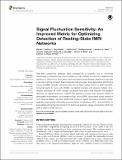| dc.contributor.author | DeDora, Daniel J. | |
| dc.contributor.author | Nedic, Sanja | |
| dc.contributor.author | Katti, Pratha | |
| dc.contributor.author | Arnab, Shafique | |
| dc.contributor.author | Wald, Lawrence | |
| dc.contributor.author | Takahashi, Atsushi | |
| dc.contributor.author | Van Dijk, Koene R. A. | |
| dc.contributor.author | Strey, Helmut H. | |
| dc.contributor.author | Mujica-Parodi, Lilianne R. | |
| dc.date.accessioned | 2016-08-15T20:37:31Z | |
| dc.date.available | 2016-08-15T20:37:31Z | |
| dc.date.issued | 2016-05 | |
| dc.identifier.issn | 1662-453X | |
| dc.identifier.uri | http://hdl.handle.net/1721.1/103922 | |
| dc.description.abstract | Task-free connectivity analyses have emerged as a powerful tool in functional neuroimaging. Because the cross-correlations that underlie connectivity measures are sensitive to distortion of time-series, here we used a novel dynamic phantom to provide a ground truth for dynamic fidelity between blood oxygen level dependent (BOLD)-like inputs and fMRI outputs. We found that the de facto quality-metric for task-free fMRI, temporal signal to noise ratio (tSNR), correlated inversely with dynamic fidelity; thus, studies optimized for tSNR actually produced time-series that showed the greatest distortion of signal dynamics. Instead, the phantom showed that dynamic fidelity is reasonably approximated by a measure that, unlike tSNR, dissociates signal dynamics from scanner artifact. We then tested this measure, signal fluctuation sensitivity (SFS), against human resting-state data. As predicted by the phantom, SFS-and not tSNR-is associated with enhanced sensitivity to both local and long-range connectivity within the brain's default mode network. | en_US |
| dc.description.sponsorship | National Institutes of Health (U.S.) (NIDA-1R2DA03846701 LRMP) | en_US |
| dc.description.sponsorship | National Science Foundation (U.S.) (CBET-1264440 LRMP) | en_US |
| dc.language.iso | en_US | |
| dc.publisher | Frontiers Media S.A. | en_US |
| dc.relation.isversionof | http://dx.doi.org/10.3389/fnins.2016.00180 | en_US |
| dc.rights | Creative Commons Attribution 4.0 International License | en_US |
| dc.rights.uri | http://creativecommons.org/licenses/by/4.0/ | en_US |
| dc.source | Frontiers | en_US |
| dc.title | Signal Fluctuation Sensitivity: An Improved Metric for Optimizing Detection of Resting-State fMRI Networks | en_US |
| dc.type | Article | en_US |
| dc.identifier.citation | DeDora, Daniel J., Sanja Nedic, Pratha Katti, Shafique Arnab, Lawrence L. Wald, Atsushi Takahashi, Koene R. A. Van Dijk, Helmut H. Strey and Lilianne R. Mujica-Parodi. "Signal Fluctuation Sensitivity: An Improved Metric for Optimizing Detection of Resting-State fMRI Networks." Frontiers in Neuroscience 10:Article 180 (May 2016), pp.1-15. | en_US |
| dc.contributor.department | Harvard University--MIT Division of Health Sciences and Technology | en_US |
| dc.contributor.department | McGovern Institute for Brain Research at MIT | en_US |
| dc.contributor.mitauthor | Wald, Lawrence | en_US |
| dc.contributor.mitauthor | Takahashi, Atsushi | en_US |
| dc.contributor.mitauthor | Mujica-Parodi, Lilianne R. | en_US |
| dc.relation.journal | Frontiers in Neuroscience | en_US |
| dc.eprint.version | Final published version | en_US |
| dc.type.uri | http://purl.org/eprint/type/JournalArticle | en_US |
| eprint.status | http://purl.org/eprint/status/PeerReviewed | en_US |
| dspace.orderedauthors | DeDora, Daniel J.; Nedic, Sanja; Katti, Pratha; Arnab, Shafique; Wald, Lawrence L.; Takahashi, Atsushi; Van Dijk, Koene R. A.; Strey, Helmut H.; Mujica-Parodi, Lilianne R. | en_US |
| dspace.embargo.terms | N | en_US |
| mit.license | PUBLISHER_CC | en_US |
